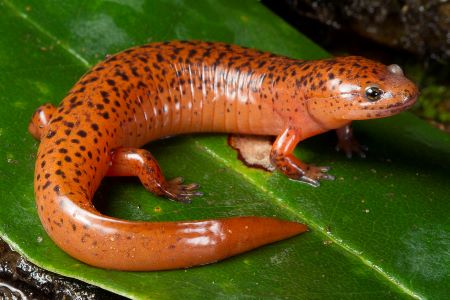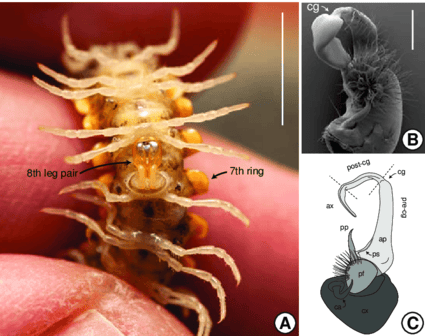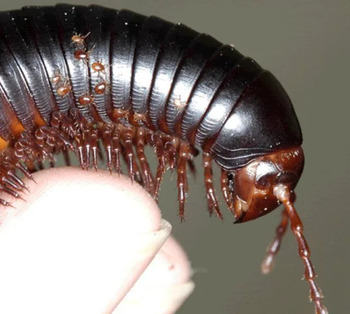Red Salamander: Difference between revisions
Creating Red Salamander Page MK. I |
Updated intro and got most references established |
||
| Line 1: | Line 1: | ||
{| class="wikitable" style="text-align:center; float:right; margin-left: 10px; | {| class="wikitable" style="text-align:center; float:right; margin-left: 10px; | ||
|+ !colspan="2" style="min-width:12em; text-align: center; background-color: rgb(240,150,110)|'''Scientific Classification'''<ref name="NatureServe">Pseudotriton ruber | NatureServe Explorer. (n.d.). Retrieved April 30, 2025, from https://explorer.natureserve.org/Taxon/ELEMENT_GLOBAL.2.101775/Pseudotriton_ruber</ref> <ref name="ADW">Miller, R. (n.d.). Pseudotriton ruber (Red Salamander). Animal Diversity Web. Retrieved April 30, 2025, from https://animaldiversity.org/accounts/Pseudotriton_ruber/</ref> <ref name="Red Salamander Photo 1">Todd Pierson. Red Salamander. (n.d.). Retrieved April 30, 2025, from https://herpsofnc.org/red-salamander/</ref> | |+ !colspan="2" style="min-width:12em; text-align: center; background-color: rgb(240,150,110)|'''Scientific Classification'''<ref name="NatureServe">Pseudotriton ruber | NatureServe Explorer. (n.d.). Retrieved April 30, 2025, from https://explorer.natureserve.org/Taxon/ELEMENT_GLOBAL.2.101775/Pseudotriton_ruber</ref> <ref name="ADW">Miller, R. (n.d.). Pseudotriton ruber (Red Salamander). Animal [[Diversity]] Web. Retrieved April 30, 2025, from https://animaldiversity.org/accounts/Pseudotriton_ruber/</ref> <ref name="Red Salamander Photo 1">Todd Pierson. Red Salamander. (n.d.). Retrieved April 30, 2025, from https://herpsofnc.org/red-salamander/</ref> | ||
|colspan="2" |[[File:Red Salamander Cover Pic.jpg|451px|right|Caption]] | |colspan="2" |[[File:Red Salamander Cover Pic.jpg|451px|right|Caption]] | ||
|- | |- | ||
| Line 31: | Line 31: | ||
|} | |} | ||
Psuedotriton ruber, more commonly known as the Red Salamander, are larger amphibians belonging to the Plethodontidae family. In latin, ruber means "red" and in greek psuedotriton means "false god" in reference to Triton, the son of Posidon. Others say that this could also mean "false newt" <ref name="AmphibiaWeb">AmphibiaWeb—Pseudotriton ruber. (n.d.). Retrieved April 30, 2025, from https://amphibiaweb.org/species/4198</ref> <ref name="VHS">Virginia Herpetological Society. (n.d.). Retrieved April 30, 2025, from http://www.virginiaherpetologicalsociety.com</ref>. These are amphibians who have a redish orangish skin pigmentation with black spots along the back and chin, a yellow iris, and a rather shorter tail. <ref name="DWR">Red Salamander. (n.d.). Retrieved April 30, 2025, from https://dwr.virginia.gov/wildlife/information/northern-red-salamander/</ref>. The size of Red [[Salamanders]] can very between 11 to 18 cm, or 4.33 to 7.09 in, with females tending to be slightly larger and all contain 16 grooves along their body. As they age, it has been shown that adults tend to turn a purplish brown, loosing their vibrant colors over time <ref name="Wildlife Resources Agency">Red Salamander | State of Tennessee, Wildlife Resources Agency. (n.d.). Retrieved April 30, 2025, from https://www.tn.gov/twra/wildlife/amphibians/salamanders/red-salamander.html</ref>. There are 4 infraspecies within this species (Pseudotriton ruber nitidus, Pseudotriton ruber ruber, Pseudotriton ruber schencki, and Pseudotriton ruber vioscai), and they often get mistaken for Mud Salamanders. Their yellow iris is what separates them from the Mud Salamander species, who has a brown iris <ref name="NatureServe"></ref>. | |||
== Ecology == | |||
Red Salamanders are often found in colder springs, seepages, and springs in forested riparian corridors, but can also live away from aquatic environments. <ref name="Indiana">Red Salamander (Pseudotriton ruber)—Indiana Herp Atlas. (n.d.). Retrieved April 30, 2025, from https://www.inherpatlas.org/species/pseudotriton_ruber</ref>. | |||
<br></br> | <br></br> | ||
<br></br> | <br></br> | ||
</br></br> | </br></br> | ||
[[File:Gonopods.png|426px|left|thumb|Gonopods of the millipede species ''Sigmocheir furcata''<ref name="Gonopods">Marek, P. ''et al.'' (2014). A species catalog the millipede family Xystodesmidae (Diplopoda: Polydesmida). Virginia Museum of Natural History. https://www.researchgate.net/publication/267810849_A_species_catalog_the_millipede_family_Xystodesmidae_Diplopoda_Polydesmida</ref>]] | [[File:Gonopods.png|426px|left|thumb|Gonopods of the millipede species ''Sigmocheir furcata''<ref name="Gonopods">Marek, P. ''et al.'' (2014). A species catalog the millipede family Xystodesmidae (Diplopoda: Polydesmida). Virginia Museum of Natural History. https://www.researchgate.net/publication/267810849_A_species_catalog_the_millipede_family_Xystodesmidae_Diplopoda_Polydesmida</ref>]] | ||
Revision as of 06:25, 30 April 2025
 | |
| Kingdom: | Animalia |
|---|---|
| Phylum: | Craniata |
| Subphylum: | Vertebrata |
| Superclass: | Gnathostomata |
| Class: | Amphibia |
| Subclass: | Lissamphibia |
| Order: | Caudata |
| Family: | Plethodontidae |
| Genus: | Pseudotriton |
Psuedotriton ruber, more commonly known as the Red Salamander, are larger amphibians belonging to the Plethodontidae family. In latin, ruber means "red" and in greek psuedotriton means "false god" in reference to Triton, the son of Posidon. Others say that this could also mean "false newt" [4] [5]. These are amphibians who have a redish orangish skin pigmentation with black spots along the back and chin, a yellow iris, and a rather shorter tail. [6]. The size of Red Salamanders can very between 11 to 18 cm, or 4.33 to 7.09 in, with females tending to be slightly larger and all contain 16 grooves along their body. As they age, it has been shown that adults tend to turn a purplish brown, loosing their vibrant colors over time [7]. There are 4 infraspecies within this species (Pseudotriton ruber nitidus, Pseudotriton ruber ruber, Pseudotriton ruber schencki, and Pseudotriton ruber vioscai), and they often get mistaken for Mud Salamanders. Their yellow iris is what separates them from the Mud Salamander species, who has a brown iris [1].
Ecology
Red Salamanders are often found in colder springs, seepages, and springs in forested riparian corridors, but can also live away from aquatic environments. [8].

Reproduction and Life Cycle
Diet and Feeding Behaviors

Distribution
Ecological Functions
References
- ↑ Jump up to: 1.0 1.1 Pseudotriton ruber | NatureServe Explorer. (n.d.). Retrieved April 30, 2025, from https://explorer.natureserve.org/Taxon/ELEMENT_GLOBAL.2.101775/Pseudotriton_ruber
- ↑ Miller, R. (n.d.). Pseudotriton ruber (Red Salamander). Animal Diversity Web. Retrieved April 30, 2025, from https://animaldiversity.org/accounts/Pseudotriton_ruber/
- ↑ Todd Pierson. Red Salamander. (n.d.). Retrieved April 30, 2025, from https://herpsofnc.org/red-salamander/
- ↑ AmphibiaWeb—Pseudotriton ruber. (n.d.). Retrieved April 30, 2025, from https://amphibiaweb.org/species/4198
- ↑ Virginia Herpetological Society. (n.d.). Retrieved April 30, 2025, from http://www.virginiaherpetologicalsociety.com
- ↑ Red Salamander. (n.d.). Retrieved April 30, 2025, from https://dwr.virginia.gov/wildlife/information/northern-red-salamander/
- ↑ Red Salamander | State of Tennessee, Wildlife Resources Agency. (n.d.). Retrieved April 30, 2025, from https://www.tn.gov/twra/wildlife/amphibians/salamanders/red-salamander.html
- ↑ Red Salamander (Pseudotriton ruber)—Indiana Herp Atlas. (n.d.). Retrieved April 30, 2025, from https://www.inherpatlas.org/species/pseudotriton_ruber
- ↑ Marek, P. et al. (2014). A species catalog the millipede family Xystodesmidae (Diplopoda: Polydesmida). Virginia Museum of Natural History. https://www.researchgate.net/publication/267810849_A_species_catalog_the_millipede_family_Xystodesmidae_Diplopoda_Polydesmida
- ↑ sofkeya. (2023). what are these little bugs on my millipedes and how can i get rid of them?[Online forum post]. Reddit. https://www.reddit.com/r/millipedes/comments/14dnxn2/what_are_these_little_bugs_on_my_millipedes_and/